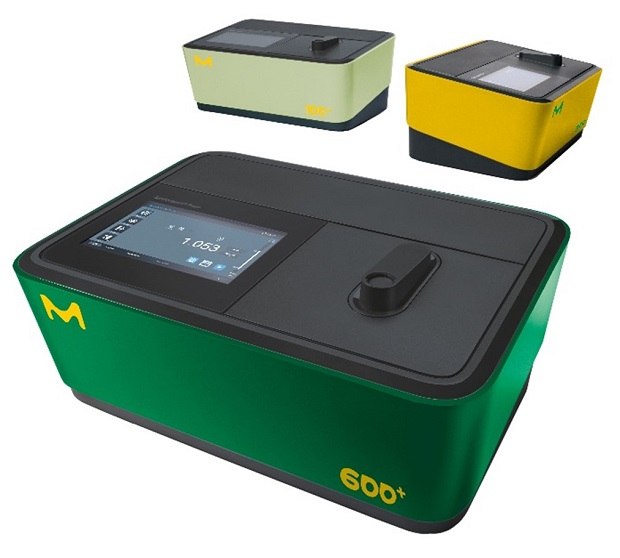Photometric Determination of Ammonium in Compost Using the Indophenol Blue Method with Calcium Chloride Extraction
Abstract
This protocol describes the photometric determination of ammonium in compost using indophenol blue utilizing Spectroquant® test kits and spectrophotometers. Ammonium ions are extracted from compost samples using a calcium chloride solution. The ions that were extracted are then mixed with hypochlorite ions to form monochloramine, which further reacts with a phenol compound to make a blue indophenol derivative which is then measured photometrically.
Section Overview:

Spectroquant® spectrophotometers - Prove 100 plus, Prove 300 plus, & Prove 600 plus
Introduction
Ammonium (NH4+) is one of the most important sources of nitrogen for plant nutrition and it is formed with the mineralization of decomposed organic matter.1 Research also has established that ammonium is the naturally preferred source of nitrogen for plant growth.2 With the increasing global demand for organic food products, farmers are resorting to the use of compost and manure. While ready-made ammonium fertilizers have defined concentrations of the cation and related compounds in them, it is important to analyze composts and manure for their accurate ammonium concentration. As the early phases of decomposition account for the loss of nitrogen as ammonia, and there is a natural loss of ammonium as the compost matures.3 Excess ammonium has also been reported to be toxic in higher plants.4
This application note details the photometric determination of ammonium in compost, using the indophenol blue method. Post the sample extraction and in a strongly alkaline solution, ammonium nitrogen is present almost entirely as ammonia, which reacts with hypochlorite ions to form monochloramine. This in turn reacts with a phenol compound to form a blue indophenol derivative that is determined photometrically.
Reagents, Instruments and Materials
Ammonium Test Kits/Reagents
For the measurement, one of the following Spectroquant® test kits is necessary:
- Spectroquant® Ammonium Cell Test (1.14544)*
- Spectroquant® Ammonium Cell Test (1.14558)
- Spectroquant® Ammonium Cell Test (1.14559)
- Spectroquant® Ammonium Test (1.14752)
- Spectroquant® Ammonium Test (1.00683)
*not compatible with Move 100
Instrument(s) & Devices
For the measurement, one of the following Spectroquant® photometers is necessary:
- Spectroquant® VIS Spectrophotometer Prove 100 Plus (1.73026)
- Spectroquant® UV/VIS Spectrophotometer Prove 300 Plus (1.73027)
- Spectroquant® UV/VIS Spectrophotometer Prove 600 Plus (1.73028)
- Spectroquant® Colorimeter Move 100 (1.73632)
Also, legacy systems
- Spectroquant® Spectrophotometer Prove 100/300/600
- Spectroquant® Photometer NOVA 30/60/60A
Software for Data transfer
- Optional Spectroquant® Prove Connect to LIMS software package (Y.11086) to transfer your data into an existing LIMS system.
Instrument Accessories
- Rectangular cells 10 mm (1.14946) and/or
- Rectangular cells 20 mm (1.14947) and/or
- Rectangular cells 50 mm (1.14944)
Other Reagents and Accessories
- Calcium chloride dihydrate for analysis (1.02382)
- Water for analysis (1.16754)
- Charcoal activated for soil tests
- Folded filter
Experimental Procedure
Reagent Preparation
Dissolve 3.68 g of calcium chloride dihydrate for analysis with 1 L of water to prepare a 0.025 mol/L calcium chloride solution.
Sample Preparation
- In a glass bottle mix 50 g of a naturally moist sample, free from coarse stones, with 100 mL of the calcium chloride solution.
- Add 1 spatula-tip full of activated charcoal for soil tests and shake the closed bottle in a shaking machine for 1 hour (alternative: stir in a beaker).
- Let the suspension settle and filter through a folded filter.
- For the determination of the water content, dry a similar sample to constant weight in the drying kiln at 105 °C. Drying of the sample before the determination is not advisable because of the fast change in the nitrogen forms.
- The analysis should take place very quickly.
- Storing the sample in plastic bags at room temperature changes the analysis values after a short time already.
Analysis
Determine with one of the above-mentioned test kits.
Calculation
Ammonium content in mg/kg NH4+ = analysis value in mg/L NH4+ x 2
See more applications for photometry at Protocols and Application Notes
References
To continue reading please sign in or create an account.
Don't Have An Account?